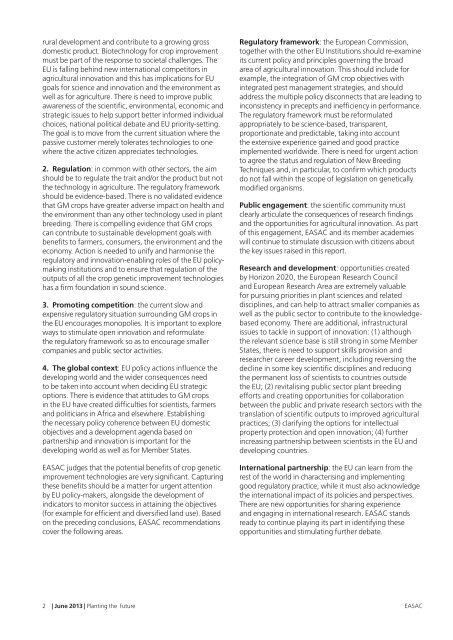Planting the future: opportunities and challenges for using ... - EASAC
Planting the future: opportunities and challenges for using ... - EASAC
Planting the future: opportunities and challenges for using ... - EASAC
You also want an ePaper? Increase the reach of your titles
YUMPU automatically turns print PDFs into web optimized ePapers that Google loves.
ural development <strong>and</strong> contribute to a growing gross<br />
domestic product. Biotechnology <strong>for</strong> crop improvement<br />
must be part of <strong>the</strong> response to societal <strong>challenges</strong>. The<br />
EU is falling behind new international competitors in<br />
agricultural innovation <strong>and</strong> this has implications <strong>for</strong> EU<br />
goals <strong>for</strong> science <strong>and</strong> innovation <strong>and</strong> <strong>the</strong> environment as<br />
well as <strong>for</strong> agriculture. There is need to improve public<br />
awareness of <strong>the</strong> scientific, environmental, economic <strong>and</strong><br />
strategic issues to help support better in<strong>for</strong>med individual<br />
choices, national political debate <strong>and</strong> EU priority-setting.<br />
The goal is to move from <strong>the</strong> current situation where <strong>the</strong><br />
passive customer merely tolerates technologies to one<br />
where <strong>the</strong> active citizen appreciates technologies.<br />
2. Regulation: in common with o<strong>the</strong>r sectors, <strong>the</strong> aim<br />
should be to regulate <strong>the</strong> trait <strong>and</strong>/or <strong>the</strong> product but not<br />
<strong>the</strong> technology in agriculture. The regulatory framework<br />
should be evidence-based. There is no validated evidence<br />
that GM crops have greater adverse impact on health <strong>and</strong><br />
<strong>the</strong> environment than any o<strong>the</strong>r technology used in plant<br />
breeding. There is compelling evidence that GM crops<br />
can contribute to sustainable development goals with<br />
benefits to farmers, consumers, <strong>the</strong> environment <strong>and</strong> <strong>the</strong><br />
economy. Action is needed to unify <strong>and</strong> harmonise <strong>the</strong><br />
regulatory <strong>and</strong> innovation-enabling roles of <strong>the</strong> EU policymaking<br />
institutions <strong>and</strong> to ensure that regulation of <strong>the</strong><br />
outputs of all <strong>the</strong> crop genetic improvement technologies<br />
has a firm foundation in sound science.<br />
3. Promoting competition: <strong>the</strong> current slow <strong>and</strong><br />
expensive regulatory situation surrounding GM crops in<br />
<strong>the</strong> EU encourages monopolies. It is important to explore<br />
ways to stimulate open innovation <strong>and</strong> re<strong>for</strong>mulate<br />
<strong>the</strong> regulatory framework so as to encourage smaller<br />
companies <strong>and</strong> public sector activities.<br />
4. The global context: EU policy actions influence <strong>the</strong><br />
developing world <strong>and</strong> <strong>the</strong> wider consequences need<br />
to be taken into account when deciding EU strategic<br />
options. There is evidence that attitudes to GM crops<br />
in <strong>the</strong> EU have created difficulties <strong>for</strong> scientists, farmers<br />
<strong>and</strong> politicians in Africa <strong>and</strong> elsewhere. Establishing<br />
<strong>the</strong> necessary policy coherence between EU domestic<br />
objectives <strong>and</strong> a development agenda based on<br />
partnership <strong>and</strong> innovation is important <strong>for</strong> <strong>the</strong><br />
developing world as well as <strong>for</strong> Member States.<br />
<strong>EASAC</strong> judges that <strong>the</strong> potential benefits of crop genetic<br />
improvement technologies are very significant. Capturing<br />
<strong>the</strong>se benefits should be a matter <strong>for</strong> urgent attention<br />
by EU policy-makers, alongside <strong>the</strong> development of<br />
indicators to monitor success in attaining <strong>the</strong> objectives<br />
(<strong>for</strong> example <strong>for</strong> efficient <strong>and</strong> diversified l<strong>and</strong> use). Based<br />
on <strong>the</strong> preceding conclusions, <strong>EASAC</strong> recommendations<br />
cover <strong>the</strong> following areas.<br />
Regulatory framework: <strong>the</strong> European Commission,<br />
toge<strong>the</strong>r with <strong>the</strong> o<strong>the</strong>r EU Institutions should re-examine<br />
its current policy <strong>and</strong> principles governing <strong>the</strong> broad<br />
area of agricultural innovation. This should include <strong>for</strong><br />
example, <strong>the</strong> integration of GM crop objectives with<br />
integrated pest management strategies, <strong>and</strong> should<br />
address <strong>the</strong> multiple policy disconnects that are leading to<br />
inconsistency in precepts <strong>and</strong> inefficiency in per<strong>for</strong>mance.<br />
The regulatory framework must be re<strong>for</strong>mulated<br />
appropriately to be science-based, transparent,<br />
proportionate <strong>and</strong> predictable, taking into account<br />
<strong>the</strong> extensive experience gained <strong>and</strong> good practice<br />
implemented worldwide. There is need <strong>for</strong> urgent action<br />
to agree <strong>the</strong> status <strong>and</strong> regulation of New Breeding<br />
Techniques <strong>and</strong>, in particular, to confirm which products<br />
do not fall within <strong>the</strong> scope of legislation on genetically<br />
modified organisms.<br />
Public engagement: <strong>the</strong> scientific community must<br />
clearly articulate <strong>the</strong> consequences of research findings<br />
<strong>and</strong> <strong>the</strong> <strong>opportunities</strong> <strong>for</strong> agricultural innovation. As part<br />
of this engagement, <strong>EASAC</strong> <strong>and</strong> its member academies<br />
will continue to stimulate discussion with citizens about<br />
<strong>the</strong> key issues raised in this report.<br />
Research <strong>and</strong> development: <strong>opportunities</strong> created<br />
by Horizon 2020, <strong>the</strong> European Research Council<br />
<strong>and</strong> European Research Area are extremely valuable<br />
<strong>for</strong> pursuing priorities in plant sciences <strong>and</strong> related<br />
disciplines, <strong>and</strong> can help to attract smaller companies as<br />
well as <strong>the</strong> public sector to contribute to <strong>the</strong> knowledgebased<br />
economy. There are additional, infrastructural<br />
issues to tackle in support of innovation: (1) although<br />
<strong>the</strong> relevant science base is still strong in some Member<br />
States, <strong>the</strong>re is need to support skills provision <strong>and</strong><br />
researcher career development, including reversing <strong>the</strong><br />
decline in some key scientific disciplines <strong>and</strong> reducing<br />
<strong>the</strong> permanent loss of scientists to countries outside<br />
<strong>the</strong> EU; (2) revitalising public sector plant breeding<br />
ef<strong>for</strong>ts <strong>and</strong> creating <strong>opportunities</strong> <strong>for</strong> collaboration<br />
between <strong>the</strong> public <strong>and</strong> private research sectors with <strong>the</strong><br />
translation of scientific outputs to improved agricultural<br />
practices; (3) clarifying <strong>the</strong> options <strong>for</strong> intellectual<br />
property protection <strong>and</strong> open innovation; (4) fur<strong>the</strong>r<br />
increasing partnership between scientists in <strong>the</strong> EU <strong>and</strong><br />
developing countries.<br />
International partnership: <strong>the</strong> EU can learn from <strong>the</strong><br />
rest of <strong>the</strong> world in characterising <strong>and</strong> implementing<br />
good regulatory practice, while it must also acknowledge<br />
<strong>the</strong> international impact of its policies <strong>and</strong> perspectives.<br />
There are new <strong>opportunities</strong> <strong>for</strong> sharing experience<br />
<strong>and</strong> engaging in international research. <strong>EASAC</strong> st<strong>and</strong>s<br />
ready to continue playing its part in identifying <strong>the</strong>se<br />
<strong>opportunities</strong> <strong>and</strong> stimulating fur<strong>the</strong>r debate.<br />
2 | June 2013 | <strong>Planting</strong> <strong>the</strong> <strong>future</strong> <strong>EASAC</strong>


